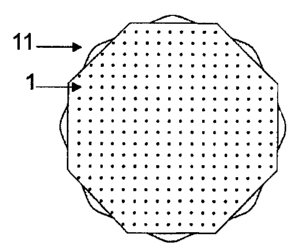Note: Descriptions are shown in the official language in which they were submitted.
CA 02548102 2006-04-10
WO 2006/005145 PCT/BR2005/000050
"ROD WITH OCTAGONAL CORE PURPOSE-BUILT FOR CIVIL
CONSTRUCTION."
State of the Art.
Since the civil construction adopted the reinforced
concrete technology, the column manufacture has been being a hand-crafted
process in which vertical boxes are set up containing long proper steel rods
in
their interior; these boxes are filled with cement mixed with water, sand and
crushed stones, which the so-caned concrete is consisted of.
The figures 1,2 and 3 show this process and its stages.
In the figure 1, we can see the initial stage of the process, in which the
steel
rods (2) are placed vertically on any support (12) and they are kept in the
position by their own stiffness or they are fastened with wires (3).
In the Figure 2, the rods are kept in position by the hangers (4), which may
occur at any number, usually according to the structural project, and they are
also made of the same steel as the rods are, and they are stuck to the rods by
either welding or wire fastening.
The Figure 3 is a general frontal view of a pillar (5) which is being built
and at
this stage it is wrapped in a wooden mold (6), whose frontal part has been
omitted in order to reveal the inside of the pillar, which will be removed
when
the concrete that will be placed in its interior is cured.
The hangers (4) usually have a gauge which is smaller than that of the main
ironwork and they are obtained by (heir own cutting and folding at the proper
dimensions and shapes, according to Figure 4, where we can see the hanger
from an upper view, here in a rectangular shape; it may take other polygonal
shapes, though, such as that of a square, a triangle, a hexagon, etc.
The raw material offered by the market to be used as rods usually has the
specific section (7), showed in the Figure 5, called rounded core rod, and the
specific surface (8), showed in the Figure 6, known as corrugated surtace.
These specific shape and surface are intended to increase the contact area and
the adhesion of the rod steel (2) and hangers (4) with the concrete, raising
the
whole resistance.
However, when the rods (2) are folded to make the hangers (4), due to the
specific section of the material, the polygons (9) which are formed do not
keep
the edges at the same plan, according to Figure 7, as the specific profile of
the
rounded core gets deformed in angles which are different from those expected.
CA 02548102 2006-04-10
WO 2006/005145 PCT/BR2005/000050
2
Such situation raises the cost and lengthens the timespan of the
constructions,
for two workers are usually needed to fasten the rods with wire in order to
have
the edges at the same plan again.
ADVANCE IN THE STATE OF THE ART UNDERTAKEN BY THIS PATENT
The ROD WITH OCTAGONAL CORE PURPOSE-BUILT FOR CIVIL
CONSTRUCTION, object of this patent, due to the octagonal profile of its core,
makes itself as it is folded, either manually or industrially, not to form
angles
which make the hanger have the edges at distinct plans.
ILLUSTRATIONS AND EXPLANATIONS ON THE OBJECT OF THIS PATENT
The Figure 8 shows the octagonal profile (10) of the ROD WITH OCTAGONAL
CORE PURPOSE-BUILT FOR CIVIL CONSTRUCTION (1) and the Figure 9
shows its specific section (11), derived from its specific corrugated surface.
The Figure 10 shows the system of the forces applied when folding the rods,
from any profile of the section, both manually and industrially: - the rod (2)
is
placed in the correct position on the folding bolt by the fasteners (12) and
(12
A); at this point it gets folded by the action of the force (14).
The Figure 11 shows, in a frontal view, the results which are obtained;
although
the expected results are those of the straight defined by the points ABD, in
the
practice, folds which are distributed statistically by the angles formed by
the
straights ABC and ABE are obtained, and it is evident that in the formation of
a
squared-shaped hanger (4), four random dispersions like these are added, so
that the hanger (4) does not result in co-planned, with the consequences which
were pointed out.
The reason is obvious : -when it comes to folding a disc-like profile rod (2),
the
resistance against the fold force is the same in any direction due to the
equality
of the diameters; as to the octagonal profile rod (2), due to the parallelism
of the
opposite sides of such a polygon, the rod gets firm and correctly positioned
on
the folding bolt (13) by the fasteners (12) and (12 A), according to Figure
12,
and the area of the cut H...I, which corresponds to the polygon apothems, is
smaller than F...G, which corresponds to its diagonals and is, thus, the area
with the smallest resistance to the effort and it is where the fold
effectively
occurs, resulting in co-planned hangers (4).
